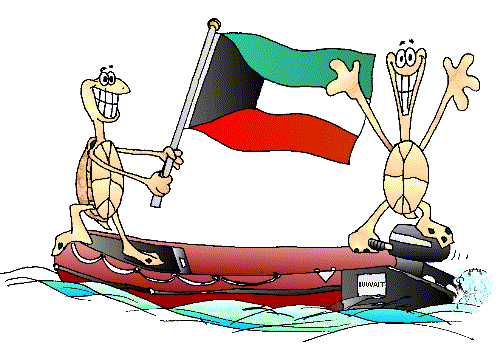

On Monday, April 22, 1996, maintenance workers at the Shuaiba power station in Kuwait discovered a problem. A screen that usually filters the water taken in from the Gulf had failed. Now two sea turtles were swimming in a 2000 sq metre (2350 sq yard) intake pool.
Because there is a drop of 7 m (22 feet) from the intake pipe to the surface of the pool, it was impossible for the turtles to get out of the pool on their own. The workers knew the turtles had to be removed quickly because the pool was heavily chlorinated, enough to kill the turtles if they remained there. They called the Environmental Protection Council of Kuwait, who in turn called on the Kuwait Diving Team for Rescue and Salvage (KDTRS).
The KDTRS was originally formed by members of the Kuwait Science Club to clean up the damages to Kuwait's nearshore waters by the Gulf War. They had lots of experience removing sunken vessels, but none with rescuing sea turtles. When the call came to them late Monday evening, they began to plan a rescue. One of their first actions was to seek advice on the Internet.
Abdullah Al-Fadhel searched the WorldWide Web and found Turtle Trax. He sent us an appeal for help. Although we don't have experience with capturing sea turtles, we knew where to find people who did. We forwarded the KDTRS appeal to the CTURTLE mailing list. Meanwhile, Abdul found more possible sources of help through the Web. It wasn't long before advice started to arrive. Eventually, these responses provided all the details needed to carry out a successful rescue.
On Tuesday morning, April 23, members of the KDTRS went to the Shuaiba power station. What they saw was not encouraging. Besides the large drop down to the pool's surface, there was a powerful surge, caused by the turbines. Diving in the pool was not possible. The turtles had to be captured when they came to the surface to breathe, making the rescue much harder.
The KDTRS were not discouraged, however. Using the advice Abdul had gathered from the Internet, they simply planned accordingly. Early Wednesday, April 24, the KDTRS arrived at the power station to put their plan into action. They had decided to lower four inflatable boats into the pool. Volunteers wearing flotation vests would use a specially designed net. They knew their job would not be an easy one.
One problem was that the rescuers had no idea where the turtles would surface next. This was complicated further because the turtles spent such little time on the surface, usually only a few seconds. After many long hours on a day hot even for Kuwait, they had managed to catch a turtle three times, only to have it escape the net each time. The team was getting tired, but they were determined to rescue the turtles.
Finally, they decided to stop using the engines on the boats, since it was felt that this could be disturbing the turtles. On their next attempt, they were successful in catching both turtles. The animals were placed in a boat that had been specially prepared with wet foam-rubber padding, the way they'd been advised through the net. The boat was hoisted by a crane onto a truck, which took the turtles to a beach where they could be released.
On Thursday, April 25, Abdul sent us the following email:
We just got back from the location of the two turtles and they are now home free, deep in the beautiful blue sea of Kuwait. I would like to personally thank you and your wife for your help. There were many people who emailed us with there advices on how to deal with this kind of situation. We are greatly thankful to them all. The story has some great details, and having five cameras, we are waiting to see if we had taken some good pictures. Thank you again, and please thank every body for me.
Abdul
Kuwait Diving Team for Rescue and Salvage
http://freekuwait.com.kw
Although the rescue was difficult and tiring, lasting nearly 12 hours, the KDTRS was rightfully jubilant over their success. Thanks in part to their clever use of the Internet, two sea turtles are safe today. It was heartening to see how the Web, email, and a mailing list worked together to provide a fast response that helped this rescue to take place.
The story had another positive aspect. The rescue of the turtles caught the interest of the people of Kuwait. It ran on the front pages of the papers, was picked up by the Kuwait News Agency, and was featured on Kuwait TV. This meant that many people who probably never thought much about sea turtles became aware of them and their plight.
Turtle Trax offers congratulations and a mahalo nui loa to the Kuwait Diving Team, as well as a mahalo to all those who responded.